Southwell Minster: The "Village Cathedral"
by Julia Hickey
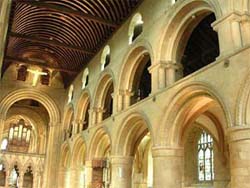 Southwell Minster became the cathedral of Nottinghamshire
in 1884, but this church of the Blessed Virgin Mary has been a
minster (or missionary church) covering most of Nottinghamshire
since Saxon times. Sometimes called the "village cathedral," it
boasts Roman remains, a Saxon carving, solid Norman architecture
and the world famous chapter house filled with unique carvings.
No wonder Cardinal Wolsey liked the place so much that he stayed
in the Archbishop's Palace for three months in the summer of
1530. Southwell Minster became the cathedral of Nottinghamshire
in 1884, but this church of the Blessed Virgin Mary has been a
minster (or missionary church) covering most of Nottinghamshire
since Saxon times. Sometimes called the "village cathedral," it
boasts Roman remains, a Saxon carving, solid Norman architecture
and the world famous chapter house filled with unique carvings.
No wonder Cardinal Wolsey liked the place so much that he stayed
in the Archbishop's Palace for three months in the summer of
1530.
Visitors can follow an hour-long audio tour or hunt for the 28
wooden mice that can be found carved into the wooden furniture in
the church. A tour should also include an exploration of the
exterior of the building with its Norman arches, dog tooth
carving and distinctive towers on either side of the West door,
not to mention the assortment of gargoyles and grotesques that
look out onto the quiet churchyard and the remnants of the
Archbishop's Palace.
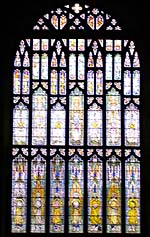 Inside the Minster, take time to admire the
modern west window that throws light into the Norman nave with
its typical sturdy columns leading up towards the triforum --the
blind level (so called because there are no windows) and the
third level (called the clerestory). The sandstone glows with
light and your eyes are naturally drawn heavenwards towards the
wooden barrel vaulted ceiling. The beams are not original.
Unfortunately the Minster was struck by lightning on Bonfire
Night in 1711 and the wooden roof was destroyed in the fire that
followed. Inside the Minster, take time to admire the
modern west window that throws light into the Norman nave with
its typical sturdy columns leading up towards the triforum --the
blind level (so called because there are no windows) and the
third level (called the clerestory). The sandstone glows with
light and your eyes are naturally drawn heavenwards towards the
wooden barrel vaulted ceiling. The beams are not original.
Unfortunately the Minster was struck by lightning on Bonfire
Night in 1711 and the wooden roof was destroyed in the fire that
followed.
The nave and crossing are excellent examples of the Romanesque
style, and more evidence of the Roman builders who inspired the
Norman masons can be found elsewhere in the church. A fragment
of the original Saxon floor remains in the south transept. It is
decorated with recycled mosaic tiles found in the remains of a
Roman villa. A fragment of painted plaster dating from the same
period can be seen nearby. The quire screen is carved into an
intricate network of foliage, fretwork and faces. Beyond the
organ the quire is a good example of the Early English style and
contains several 14th-century misericords (choir stalls), many of
which are delightfully carved and include examples of green men
with foliage sprouting from ears, nose and mouth.
Visitors should also be on the lookout for the oldest carving in
the Minster, which dates from the Saxon period. Look for a
tympanum -- a round-headed lintel above a door way -- in the
north transept. St Michael is shown fighting a dragon. The
dragon's tail is particularly impressive as it twists and coils
like an illuminated letter.
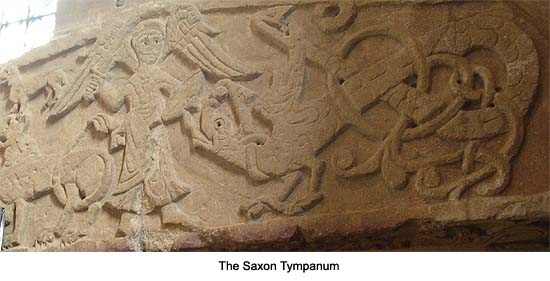 The font, found in the nave, explains a great deal of the
Minster's history. It is engraved with the date 1661 and was
commissioned to replace the original font, which was destroyed by
Cromwell's armies. It is sad to think that this lovely building
faired relatively well during the tumultuous religious upheavals
of the Tudor period only to fall victim to Scottish
parliamentarian troops, who reduced the Archbishop's palace to
rubble and destroyed the majority of the medieval windows. They
also found time to deface the dragons happily playing in the
foliage of the doorway leading to the chapterhouse. Of the
glass, little remains except for the occasional fragment. There
are four panels of 16th century glass, but the majority of the
windows were completed during the Victorian period. The Great
West Window was completed in 1996 and is called "The Seven Acts
of Creation." The angels add to the sense of light and peace
that fills the nave.
The font, found in the nave, explains a great deal of the
Minster's history. It is engraved with the date 1661 and was
commissioned to replace the original font, which was destroyed by
Cromwell's armies. It is sad to think that this lovely building
faired relatively well during the tumultuous religious upheavals
of the Tudor period only to fall victim to Scottish
parliamentarian troops, who reduced the Archbishop's palace to
rubble and destroyed the majority of the medieval windows. They
also found time to deface the dragons happily playing in the
foliage of the doorway leading to the chapterhouse. Of the
glass, little remains except for the occasional fragment. There
are four panels of 16th century glass, but the majority of the
windows were completed during the Victorian period. The Great
West Window was completed in 1996 and is called "The Seven Acts
of Creation." The angels add to the sense of light and peace
that fills the nave.
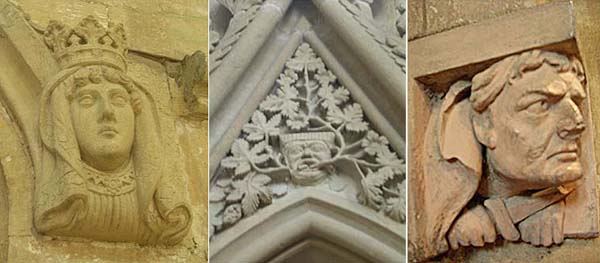
The real treasure of Southwell Minster is the Chapter House,
which is filled with foliate decoration, leaf-sprouting green men
and a fine assortment of real and mythical creatures. Be
prepared to spend some time studying the carvings in this space;
your patience will be by a glimpse of a snout here, a grimacing
face there and of course the dragons who play hide and seek in
the world famous "Leaves of Southwell." It is perhaps not
surprising that the masons were inspired by a woodland theme.
After all, the majority of the stone was quarried in Mansfield
and then transported through Sherwood Forest.
Then it is time for a coffee. The Minster offers good
hospitality and an excellent shop, but for a real treat, go to
the Saracen's Head Hotel. The wooden halftimbered building with
its central archway -- wide enough for a coach or a farm cart --
dates from the 12th century. It has been visited by King John,
Edward I, II, III and IV and most notably by King Charles I, who
gave himself up to the Scots here and was then handed over to the
parliamentarians before finally being executed. It is said that
the oldest part of this building is haunted by this unhappy
monarch. This is perhaps not surprising when visitors realise
that before Charles was executed the hotel was called the King's
Arms, but the name was changed in 1651 to The Saracen's Head
because it was believed that Charles was executed with a Saracen
sword dating from the crusades. There were no creaking
floorboards or unexpected drafts, just an extremely tempting bar
menu and a pleasant rest in the lounge area!
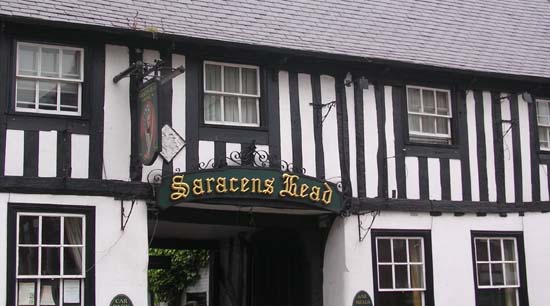
More Information:
We regret that we no longer have the resources to maintain up-to-date links and/or hours and pricing details for the various sites and attractions listed on this website. For more information about the location(s) listed above, please use your favorite search engine or visit Wikipedia.
Julia Hickey is passionate about England's heritage and particularly of Cumbria, where her husband comes from. In between dragging her family around the country to a variety of historic monuments, she works part-time as a senior lecturer at Sheffield Hallam University. She spends the rest of her week writing. In her spare time, she enjoys walking, dabbling in family history, cross-stitch, tapestry and photography.
Article and photos © 2006 Julia Hickey
|
